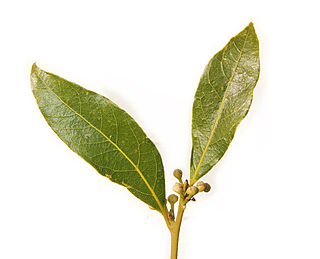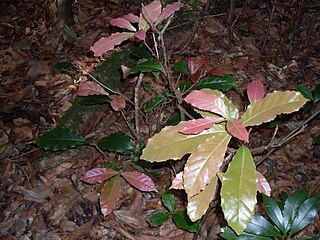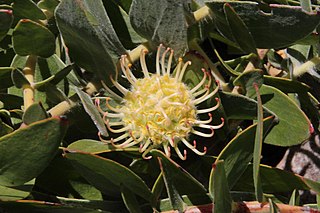
The bay leaf is an aromatic leaf commonly used in cooking. It can be used whole or in a dried or ground form.

Laurus nobilis is an aromatic evergreen tree or large shrub with green, glabrous smooth leaves, in the flowering plant family Lauraceae. It is native to the Mediterranean region and is used as bay leaf for seasoning in cooking. Its common names include bay tree, bay laurel, sweet bay, true laurel, Grecian laurel, or simply laurel. Laurus nobilis figures prominently in classical Greco-Roman culture.

Tripe soup or tripe stew is a soup or stew made with tripe.

Cinnamomum tamala, Indian bay leaf, also known as tezpat, tezapatta,Malabar leaf, Indian bark, Indian cassia, or malabathrum, is a tree in the family Lauraceae that is native to India, Bangladesh, Nepal, Bhutan, and China. It can grow up to 20 m (66 ft) tall. Its leaves have a clove-like aroma with a hint of peppery taste; they are used for culinary and medicinal purposes. It is thought to have been one of the major sources of the medicinal plant leaves known in classic and medieval times as malabathrum.

Al pastor, also known as tacos al pastor, is a taco made with spit-grilled pork. Based on the lamb shawarma brought by Lebanese immigrants to Mexico, al pastor features a flavor palate that combines traditional Middle Eastern spices with those indigenous to central Mexico. It is a popular street food that has spread to the United States. In some places of northern Mexico, as in Baja California, it is known as taco de adobada. A similar dish from Puebla with different spices is tacos árabes.

Peumus boldus, the only species in the genus Peumus, is commonly known as boldo. This tree of the family Monimiaceae is natively endemic to the central region of Chile, occurring from 33° to 40° southern latitude. Boldo has also been introduced to Europe and North Africa, though it is not often seen outside botanical gardens.

Adenanthos is a genus of Australian native shrubs in the flowering plant family Proteaceae. Variable in habit and leaf shape, it is the only genus in the family where solitary flowers are the norm. It was discovered in 1791, and formally published by Jacques Labillardière in 1805. The type species is Adenanthos cuneatus, and 33 species are recognised. The genus is placed in subfamily Proteoideae, and is held to be most closely related to several South African genera.

Pasteles, also known as pastelles in the English-speaking Caribbean, are a traditional dish in several Latin American and Caribbean countries. In Puerto Rico, the Dominican Republic, Trinidad and Tobago, the Caribbean coast of Colombia, and Panama, it looks like a tamale. In Central American cuisine, it more closely resembles a British pasty or an Italian calzone. In other Spanish-speaking countries, pastel is a generic term for pastry. In Hawaii, they are called pateles in a phonetic rendering of the Puerto Rican pronunciation of pasteles, as discussed below.

Lontong is an Indonesian dish made of compressed rice cake in the form of a cylinder wrapped inside a banana leaf, commonly found in Indonesia, Malaysia and Singapore. Rice is rolled inside a banana leaf and boiled, then cut into small cakes as a staple food replacement of steamed rice. The texture is similar to those of ketupat, with the difference being that the ketupat container is made from woven janur fronds, while lontong uses banana leaf instead.

Mimetes cucullatus is an evergreen shrub with several, mostly not branching, upright stems of 1–2 m (3–7 ft) high, that has been assigned to the family Proteaceae. It is the most wide-spread and most common pagoda species that can cope with a relatively large range of environmental circumstances. It is known under several names including common pagoda in English and rooistompie in Afrikaans.

Cyclemys is a genus of freshwater turtles, commonly referred to as Asian leaf turtles, from the family Geoemydidae. The genus occurs throughout Southeast and South Asia, and currently contains seven species.

Sloanea australis, commonly known as the maiden's blush, is a rainforest tree of eastern Australia. The range of natural distribution is from near Batemans Bay in southern New South Wales to Cape Tribulation in tropical Queensland. The habitat of Sloanea australis is various types of rainforest; such as littoral, warm temperate, montane rainforest, sub tropical, and tropical rainforests. Often growing in particularly moist areas, such as next to streams.

Pepes is an Indonesian cooking method using banana leaves as food wrappings. The banana-leaf package containing food is secured with lidi seumat, and then steamed or grilled on charcoal. This cooking technique allows the rich spice mixture to be compressed against the main ingredients inside the individual banana-leaf package while being cooked, and also adds a distinct aroma of cooked or burned banana leaf. Although being cooked simultaneously with food, the banana leaf is a non-edible material and is discarded after cooking.

Sundanese cuisine is the cuisine of the Sundanese people of West Java, and Banten, Indonesia. It is one of the most popular foods in Indonesia. Sundanese food is characterised by its freshness; the famous lalab eaten with sambal and also karedok demonstrate the Sundanese fondness for fresh raw vegetables. Unlike the rich and spicy taste, infused with coconut milk and curry of Minangkabau cuisine, the Sundanese cuisine displays the simple and clear taste; ranged from savoury salty, fresh sourness, mild sweetness, to hot and spicy.

Kue putu or putu bambu is an Indonesian (kue) traditional cylindrical-shaped and green-colored steamed cake. The cake is made of rice flour called suji and coloured green with extract acquired from pandan leaf, filled with palm sugar, and steamed in bamboo tubes, hence its name, and served with grated coconut. This traditional bite-size snack is commonly found in maritime Southeast Asia, particularly in Java, Indonesia, where the cake is called putu bumbung. Kue putu can also be found in the Netherlands due to its colonial ties with the Dutch East India with Indonesia.

Bumbu is the Indonesian word for a blend of spices and it commonly appears in the names of spice mixtures, sauces and seasoning pastes. The official Indonesian language dictionary describes bumbu as "various types of herbs and plants that have a pleasant aroma and flavour — such as ginger, turmeric, galangal, nutmeg and pepper — used to enhance the flavour of the food."

Lepet (Javanese), Leupeut (Sundanese), or Lepat (Malay/Indonesian) is a type of sticky rice dumpling mixed with peanuts cooked with coconut milk and packed inside a janur or palm leaf. It is a delicacy commonly found in Javanese and Sundanese cuisine, and often consumed as a snack. It is similar to lontong, but with a stickier texture and richer flavor due to the use of coconut milk and peanuts.

Leucospermum cordatum is an evergreen, creeping shrublet of about 20 cm (8 in) high from the family Proteaceae. It has pale cream flower heads, from which pink flushed styles emerge, the whole reminiscent of a pincushion. Its common name is heart-leaf pincushion in English. It flowers between July and December but the peak of the flowering period is from September to November. It is an endemic species, that is only known from two locations close to each other in the Western Cape province of South Africa.
Bayleaf is an unincorporated community in Bartons Creek Township, Wake County, North Carolina. It has an elevation of 427 ft. The center of the community lies at the intersection of Six Forks Rd, Norwood Rd, Possum Track Rd, Bayleaf Church Rd, and Honeycutt Rd.
Protea scabra, also known as the sandpaper-leaf sugarbush, is a flowering groundcover that belongs to the genus Protea. The plant is endemic to South Africa and is found from the Hottentots Holland Mountains across the Riviersonderend Mountains, the Kleinrivier Mountains and around the town of Caledon to the Swartberg mountains.

















